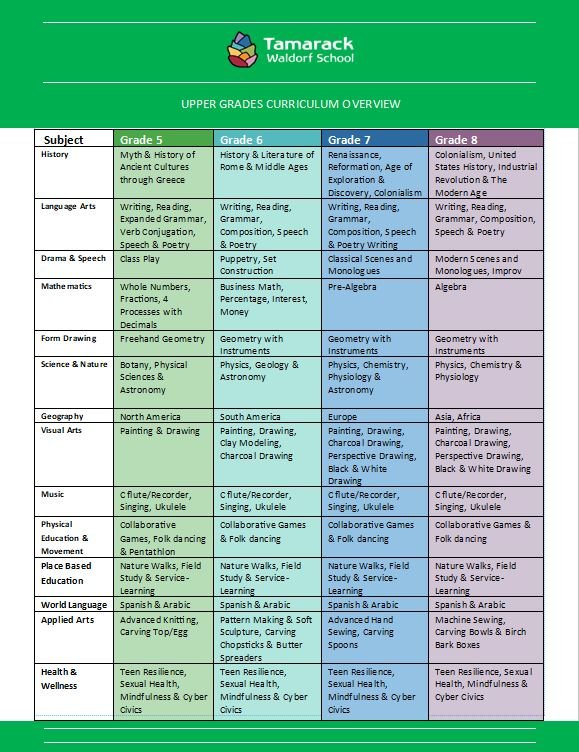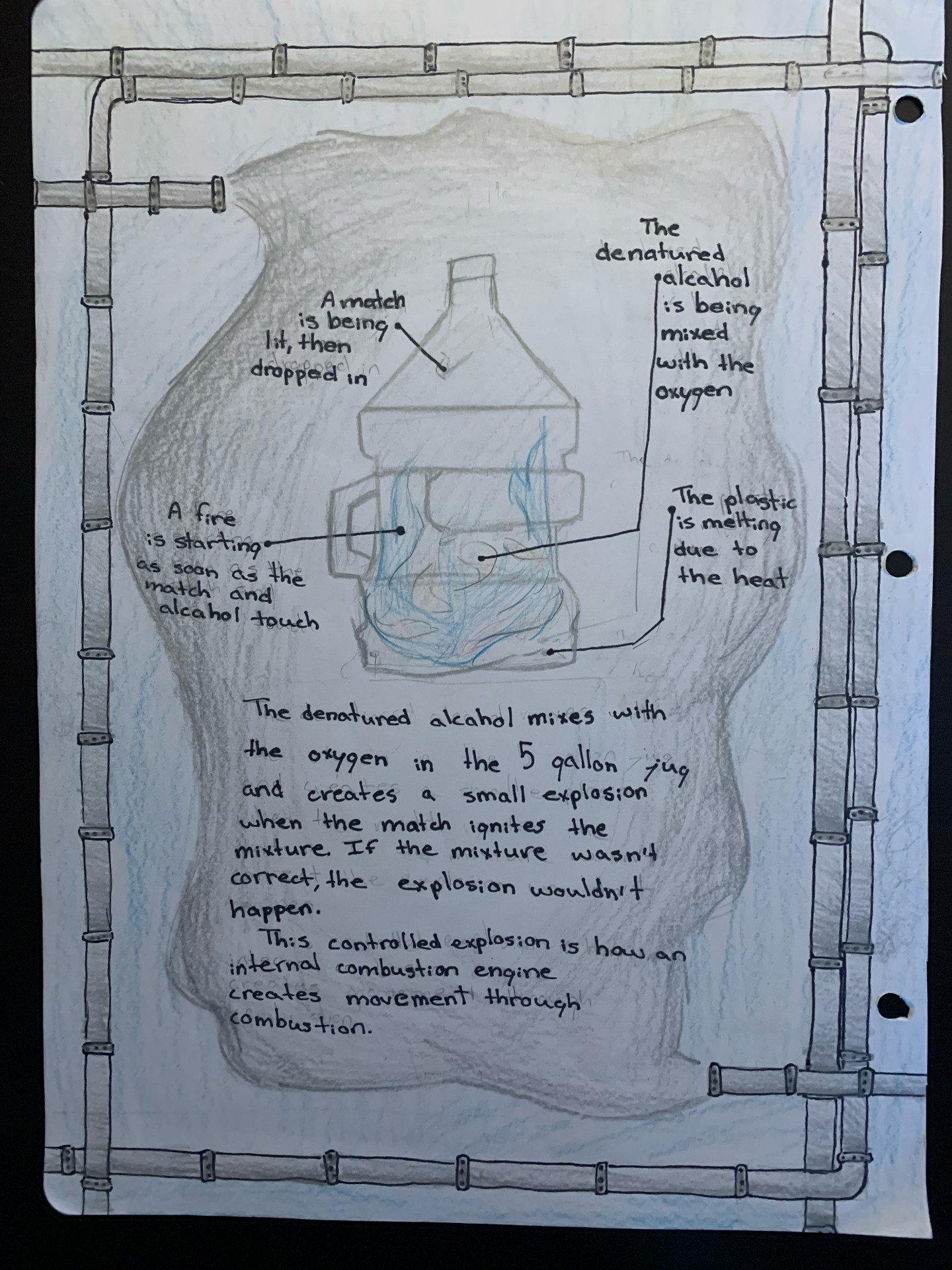“The faculty and staff of Tamarack go above and beyond for the students. This is a warm and caring community! If you are looking for a nurturing, safe and magical place for your child - this is it! They focus on not just academics but a wholistic education although, the students are able to compete academically and gain placement in many of the best high schools in Milwaukee. Arts, nature, stories and human connection are the focus. We LOVE our school!”
Download the Grade-By-Grade Upper Grades Curriculum Chart
THE WALDORF CURRICULUM
Grade school classes at Tamarack Waldorf School gradually develop in a manner that matches the growth of the child, from dreamy first grader to truth-seeking eighth grader.
Each phase of childhood focuses on an overarching theme reflected in that year’s curriculum. Starting with fairy tales as a way to introduce writing, reading, and mathematics. The curriculum builds from year to year, moving through subjects and stories that include how people have lived on the Earth (farming and house building), zoology, Norse mythology, Roman history, botany, astronomy, physics and the Renaissance.
These subjects culminate in eighth grade with the presentation of 19th and 20th century history, chemistry and algebra.
Our upper grades (5th - 8th) students use a block rotation similar to the lower grades however, subject teachers who are experts in those subjects teach the classes rather than one class teacher teaching all subjects. This shift allows students to gain confidence in their own development and helps with the transition to high school.
Learn how the curriculum meets each child developmentally as they move through the grade levels.
“My favorite thing about Tamarack is the broad range of things we are taught, and time spent outside. ”
Dive deeper into the Curriculum blocks and specialty subjects
Monthly blogs giving a more thorough exploration of each of these areas will be added throughout the year. Check Back Often.
APPLIED ARTS
Handwork and Woodwork are the two applied arts classes in the upper grades.
Handwork skills work in the area of fiber arts focusing on knitting and sewing.
The woodworking curriculum teaches students about different types of wood and carving skills.
The upper grades applied arts curriculum mirrors or supports the internal development of the preadolescent and early adolescent child. It also refines fine motor skills, supports the development of the will and provides a therapeutic experience with organic materials.
ART
Drawing, form drawing, painting, and clay modeling are fine arts that comprise a vital component of our curriculum. Working with these artistic processes is crucial to developing creative thought and complements the logical, ordered thinking of science and mathematics instruction.
The upper grades arts program has students expanding on their work with clay modeling, drawing geometric forms, form drawing and their exploration of watercolor painting integrated with their studies. They also work on drawing from nature and botany.
Sixth grade adds the study of black and white drawing as well as shadows, landscapes, and color contrasts. The seventh grade arts program will include a study of perspective drawing and masters from the Italian renaissance. The student’s will also paint subjects from their lesson content as well as times to paint more freely. There will be opportunities to explore the art of Africa in connection to geography as well.
In the eighth grade, students continue to paint but begin to paint on dry paper; allowing them to return to their work over several days. They also pre-mix their own colors and study veil and layer painting techniques. Students are challenged to develop skills in creating fuller, more detailed compositions and explore more modern techniques. The 8th grade will also work in black and white and will have an artistic study of portraiture.
DRAMA & SPEECH
Drama figures prominently in our arts and literature curriculum. In the drama program, we introduce basic acting, the history of drama and plays from the great classical and modern playwrights, with each class staging a play every year. As students progress through the grades, they take on more and more ownership of the production, from writing the plays to costume and set design. The theme of the play aligns with that grade’s curriculum.
Learn more about class plays in this blog post from March 2021
Math
Math lessons in the upper grades will be focused on inquiry-based discovery style sessions, with additional skills practice as needed. A typical discovery lesson will begin with a brief re-activation of relevant prior knowledge, and the presentation of the problem. The students will then spend the bulk of the lesson working individually, in pairs, or in small groups to discover methods that will help them. At the end of the lesson, students will present their findings to their classmates, and we will decide as a class how to formalize what we’ve learned, which will be what is kept as notes in the students’ notebooks.
MUSIC
Music is an essential aspect of who we are as human beings, and a valuable part of the whole educational experience in a Waldorf school. Regardless of past experience, every student has the capacity to participate and engage in music-making to harmonizes and lift their inner nature.
Mr. Fisher is our grade Music teacher. He provides music exploration classes for grades 1-3 and Ukulele lessons for grades 4-8 twice a week.
Throughout the upper grades students will hear music from many genres and parts of the world in order to hear, compare, and contrast, and make informed statements about the music to which they are listening. As the curriculum progresses, students work towards pitch and melodic recall both vocally and instrumentally. Students will sing together and explore harmony. Students will also work towards singing independently and collectively throughout the year in canon and two-part songs towards the end of their 8th grade year.
Upper grades students will continue playing ukulele and singing as they gain more finger and vocal dexterity. The ukulele will be played both harmonically and melodically, which will lead to instrumental arrangements of classical pieces. In 7th grade, students will add new chords to their repertoire and coordinate their voices with a variety of strumming patterns. The addition of melodic playing will be incorporated later in the year, which will give students the opportunity to use air and fingers to create a melodic line.
8th grade students will add diminished, augmented, and suspension chords to their repertoire. In addition, students will dive into the music theory behind chords and their structure.
Take a listen to our 8th graders playing the "C Jam Blues", Duke Ellington (1942)
Physical Education and Movement
The focus of movement and physical education is to make optimal functioning the priority by supporting the inner connectivities of the individual. The goal is that all students can excel at any physical endeavor they choose to embark on. Highlights of the physical education curriculum include cardio, exercise sequences, constructive rest, activities and movements that require a variety of connectivities, distal coordinations of the upper and lower body supported by the core, and balance.
In addition, students will learn folk dances and other movement activities that align with their grade’s curriculum. For example, Grade Five will participate in a Pentathlon that coincides with their study of Ancient Greece and the Grade Seven learns a dance called “Sleight” with wooden “swords” that comes from Scotland which ties into the study
Urban Hike
The primary objective of the Urban Hike class is to offer students a thrice a week direct outdoor experience with local natural places such as the Milwaukee River Greenway and the Lake Michigan lakefront. Principally, the vehicle of a nature hike is employed to encourage a regular encounter with place, from direct experience with the local neighborhood to wider consideration of our region. Secondarily, this experience offers an opportunity for regular physical exercise and a balance to classroom centered experience. When appropriate, the teacher may use this outdoor platform to address various aspects of environmental literacy.
World Languages: Spanish
Currently Spanish is Tamarack’s World Language. Students receive 2 hours of language instruction a week. Although not an immersion experience, the goal is for students to experience learning a new language and learn about countries and cultures where that language is spoken. Upper grades students will expand on their basic vocabulary and grammar learned in the lower grades and continue with learning tenses as well as being able to write and read simple descriptions, diary entries, and work on re-telling of stories in the language. Additionally, students will explore descriptions of life in countries where the language is spoken; historical, cultural, and up to-date topics.
“Hands down my favorite thing about Tamarack is the friends I made along the way. They are the most supportive people I have ever met, and we are forever bonded through Tamarack.”














